In our climatic conditions, many beautiful trees are growing, but sometimes you want to enjoy the beauty of exotic representatives of the Zamar Flora. The desire to diversify your garden prompted the gardeners to master the skills of growing trees, the birthplace of which is in thousands of kilometers from us. One of these mysterious and desired trees is the inimitable Japanese maple, which at first sight fascinates with its bright red crown. About how to grow Japanese Maple, will be discussed further.
Japanese Maple, Description
In our parks, we used to contemplate the common representative of the Flora of European latitudes - Ostromal Maple. If it comes to GUT from the country of the Rising Sun - Japanese Maple, it is worth noting that its appearance is somewhat different from ordinary maple.
- In the natural landscape, the Japanese Maple is a high shrub or leaf fall tree with a height of up to 10 m. The woodland of a tree in its crust is smooth, without cracks, red-gray or orange-ash. It is this feature that makes the Japanese maple decoration of gardens and parks throughout the year.
- The leaves of the Japanese maple dissect until the middle of the sheet, separating it into 7-11 segments. The overall diameter of the sheet is 15 cm. Different varieties dissection is different: the leaves can be both weak and hard. Leafs are sitting on squeezed cuttings up to 5 cm long.
- Due to the color of the leaves, the crowns of the Japanese maple resemble the foci of the flame in the gardens and parks. But not all varieties are the leaves of the crimson-red, sometimes there is a green-yellow and crimped color.
- Maple flowering can be observed in his homeland, in Japan. Flowers of violet red, very bright. Blossom starts in April. After flowering from the flower, the winrs are formed up to three cm long. They serve as a tool of natural reproduction, since they are hidden by the seeds of the Japanese maple.
- In our latitudes, the Japanese maple is more often grown in special ads, less often - in opened soil.
Interesting! In natural conditions in Russia, the Japanese Maple is found only in the Sakhalin region. Planting maple is so small that he is listed in the Red Book of Russia.
Types and varieties of Japanese maple with photos
The genus of Japanese maples consists of two deciduous species:
- Acer Japonicum (Japanese). Natural habitat is a mountainous area. In the culture, the tree will acquire a waste of sawn foliage, which over time changes its color from green to red-yellow. The average height of the village is 7-10 m.
- Acer Palmatum (Dlanoid). The sheet of this species is identified with the palm, which has thumbs. It is a bushes with a height of up to 6 m, in shape they resemble a ball that is transformed into an abuse tent with age. Leaves from 5 to 11 cm in diameter, have 5-9 dissected segments. There is a subspecies - maple fan or palmatum dissectum. He has small pasta leaves. The height of the maple is quite modest - up to 3 m.
The following cultivars of Japanese maple are popular in horticulture:
- Aconitifolium or aconitoliste - graceful bush in the form of a small village, which is remembered by a bright crown. The leaves are strongly dissected, have a fiery, rich-yellow and burgundy shades.
- Vtifolium or vine-hearted - a tree-like bush, which is characterized by a slow pace of development. At the variety, the milapidaya rounded-fan-like foliage, which closer to September is poured by a warm bugger.
- Sangokaku or coral is a picturesque cultivar with decorative foliage, which has deep dissected, and elegant red and coral bark.
- Garnet is a modest small sized tree with an elegant openwork crown, which is formed by hanging branches. The leaflets of this Japanese maple decorative thin-powdered, their color is modified from dark red to black and purple and dark-bug.
- Katsura - Ransetting and compact bush. Looks in gentle red-purple inflorescences. In the spring of a yellow-brick maple krona, in summer - pastel-green, closer to winter - fire-orange.
- Butterfly - a tree bangs with a five-spot leaf of green with a silver tide. On the edge of the leaves are twisted together. In the spring months, the leaves are covered with pink strokes, and closer to the end of autumn become purple.
- Orange Dream - Cultural variety with a yellowish green crown. Each sheet is decorated with a bug-colored bug. It is a tall view of up to 11 m in height.
- Bloodgood is a spectacular maple with openwork leaves, pillow ink-crimping. Does not lose color for all seasons, does not change the saturation of the paints even in the shade.
- Mikawa Yatsubusa is a low-length maple high up to 150 cm. Bush branched, squat. The foliage of the needle-shaped form, in the springtime krone green, and in the fall acquires a scarlet shade.
- SHAINA is a very slow-growing variety. For 10 years, his barrel is pulled out by a maximum of 1.5 m. Crown is thick, foliage deeply. The highest decorative achieves after dyeing leaves in bloody color. Grow mainly in containers in order to decorate the terraces and halls of the premises.
- Kiyohime is a miniature copion of a maple tall up to 180 cm. Green leaves are decorated with a red border. The saturation of the leaves is better maintained in the shade.
- Dissectum Garnet - is highlighted with coniferous foliage, which forms a rich crown. The color of foliage by autumn is painted in bloody-purple and orange colors.
Japanese Maple, Growing
Japanese maple is a graceful and gentle tree that has the right to their capsies. Therefore, it is necessary to approach its cultivation with special trepidation and attention.
How to choose Japanese maple seedlings
The selection of seedlings is a very responsible moment. The slightest error can do expensive, because in our areas this maple is quite exotic culture, which determines its high cost.
- First you need to pick up a suitable variety: if your plot is quite large, give preference to tall varieties - Orange Dream or Shirasava. If we are talking about the design of halls, terraces or small gardens, a miniature Japanese Maple Bonsai will be the perfect choice. In this form, you can grow the varieties of Mikawa Yatsubusa and Katsura.
- Making a purchase, choose a tree planted into containers. In this way, you will avoid many problems with rooting, because you can translate the maple along with a comment "native" land and do not disturb its rhizome.
- It is also necessary to take into account the age of maple: the tree must be purchased under the age of the year. More adult copies are unlikely to survive a transplant to a new place.
- Well, of course, it is necessary to consider that the seedling should be healthy, without signs of wilting, rotting, injuries insects.
Where to plant Japanese maple
This representative of the Japanese flora is not too picky in the choice of a seat landing:
- The most important thing is the presence on the plot of the damp soil, but without stagnation of the water, the root system of the maple does not make it.
- The absence of drafts - Japanese maple loves the cozy corners of the garden without dominant winds. In a quiet place, the maple will grow more actively.
- As for the lighting, there are no strict recommendations: it is enough to choose the place where the sun is breaking from time to time and there is no constant darkness.
- Also think about the "neighbors" maple. It is better not to settle the plant near high trees that will be unwilling to deprive it with light. Well, it will not hurt to highlight a little space, because its crown is sometimes twice as much as the height of the maple. The best "neighbors" of the Japanese maple is bright flowers, such as chamomiles, phlox, gladiolus, chrysanthemums.
Soil preparation for Japanese maple
Prepare the soil for maple is very easy:
- To eliminate the destructive "standing water", provide drainage in the pit. Use stones, broken bricks, granite dropout.
- The composition of the soil can be different, but it is better to use the Earth with the predominance of humus. Only soils with an increased alkaline reaction should be avoided.
- It is quite natural that the Japanese maple will grow only on fertile soil. If it is poor, a borob, humid and other organic applies to the landing pit.
Growing and Planting Technology of Japanese Maple
The cultivation of the Japanese maple consists of two stages. The first is to germinate seeds:
- The seed material is immersed in water for three hours to the upper sheath of softening.
- Prepare container with a height of at least 15 cm and a width of about 10-12 cm.
- Fill the container with a fertile substrate, make holes in it.
- Each yam is lowered by one seedly, cultivating it by 3-5 cm.
- The seeds are sprinkled with a thin layer of land, moisturize, and have a cozy place with warm air and a lack of direct light.
- It is advisable to sharpen the seeds in the guy and turn it out daily for 2-5 minutes for ventilation.
- After the appearance of a pair of leaves, seedlings can be transplanted into separate pots
The second stage is the landing of a passage maple. It passes like this:
- A pit (about 30-40 cm deep into the prepared gardening site prepared.
- 5-7 cm of drainage are placed on the bottom, then the soil is poured, moisturize it.
- The tree roll out of the container into the pit without removing the coma of the earth.
- Rhizome is sprinkled with a mixture of garden land and peat.
- The seedling is well watered, the leaves are slightly sprayed.
Japanese Maple, Care
Japanese maple care is required simple, but regular. The tree needs watering, periodic feeding and crown crown (optional).
Japanese Maple, Soil Care and Watering
- A graph of the watering of the Japanese maple is taking into account the climatic conditions and the degree of soil moisture. In the middle village watering every three days, following the moisture to be enough.
- In hot weather, along with irrigation, the crown is performed. Moisturizing early in the morning or after sunset. If the maple will feel the deficit of moisture, his foliage dries off and the branch is broken.
- In the rainy season, the Japanese cup is no additional watering.
- In the spring and autumn days, the coil circle of maple is mulched. It helps to prevent excessive moisture evaporation, and protects the roots of the tree from drying out and freezing.
Undercalinking Japanese maple
Starting from the spring, the Japanese maple fell monthly. As a rule, a dry mineral fertilizer is used, which is scattered in the rolling circle. Optionally, the mineral mixture alternate with a organic, for example, with a fresh compost. Finish the season of feeding in the first decade of July.
Important! The Japanese maple is poorly responding to fertilizers with elevated nitrogen content.
Wintering Japanese Male
Japanese maple is a pretty thermal-loving look, so survive the winter for him - real tests and strong stress. To protect the village from death, you need to prepare it to winter. In October-November, the priority circle is mulched - the mulch ball must be at least 10 centimeters height. With the help of fabric of coniferous crops, part of the maple trunk is also covered.
Maple Japanese Red, Pest and Diseases
If you take care of your maple, you are not afraid of them. If the tree is weakened, the risk of such problems increases:
- Gallery notch. Insects will fall on the bottom of the leaflery, and they make it whole colonies. Note the pest easily: red bubbles appear on the leaves. All the affected leaves will have to cut, and the maple itself is treated with insecticide or soap solution.
- Maple weevil. The bugs actively overtake greens and young shoots than deprive the maple of his decorativeness. For treatment, any insecticide is suitable.
- Bellenka. The insect gladly britizes all the above-ground parts of the maple. This leads to the loss of an attractive tree type, it fades, suspended in growth.
- Puffy dew. The fungus covers the plant with a frozen white colors. The maple is suspended physiological processes, it weakens, resets the leaves. Using treatment with antifungal preparations, the tree is rapidly restored.
Japanese Maple in Landscape Design
Although Japanese Maple can only be used at a fairly high price, but it will become the most exotic novelty of your garden. Recently, this culture is often used in the landscaped design of small Japanese-style gardens. Especially gorgeous looks like maple along Alley. If financial capabilities allow, choose different varieties, creating gradation of the color of foliage from gently gold to the blood-ink.
Not bad Japanese maple looks in a pair with other cultures. Landscape designers, assure that putting this maple along with blooming herbs, nearby water bodies or in the garden of stones, you are not giving. After all, being a rather exotic culture, the Japanese maple makes a highlight to any place, wherever it is planted.

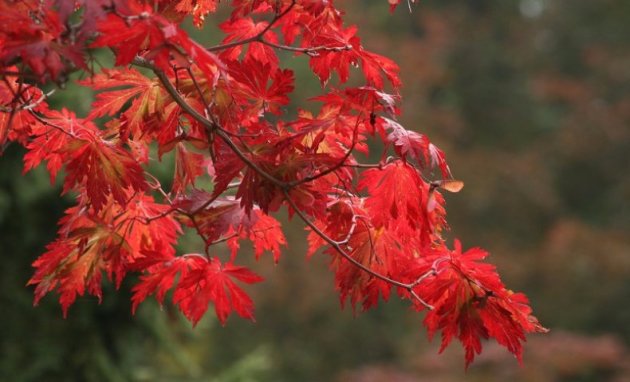
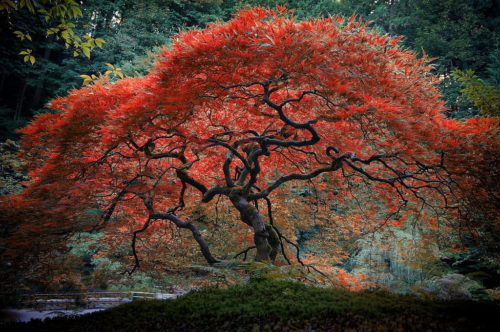
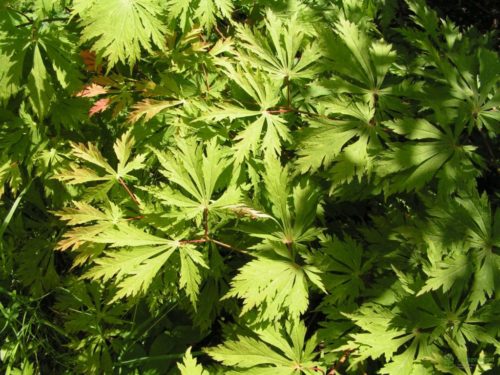
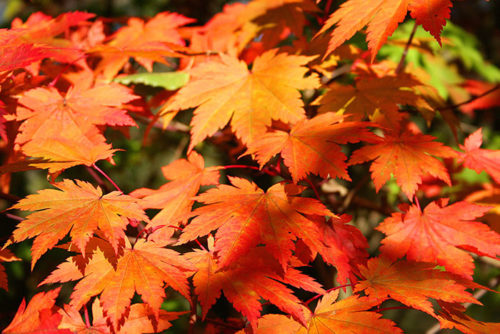
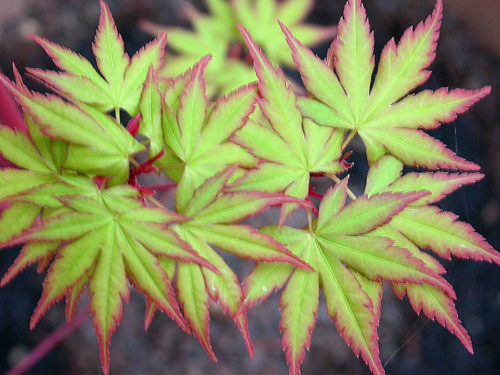
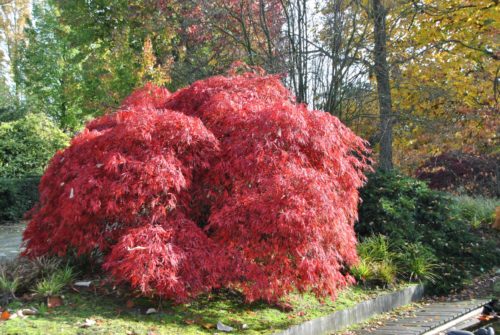
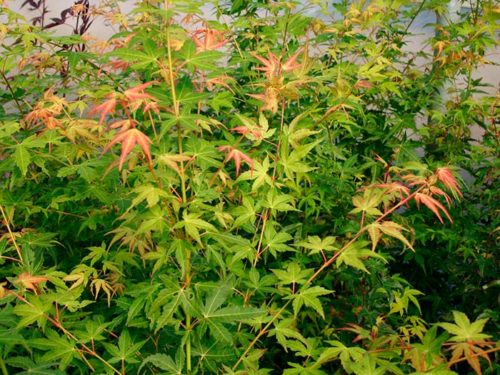
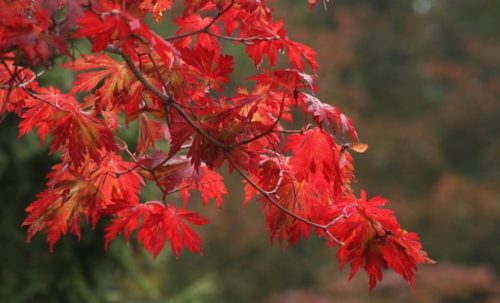
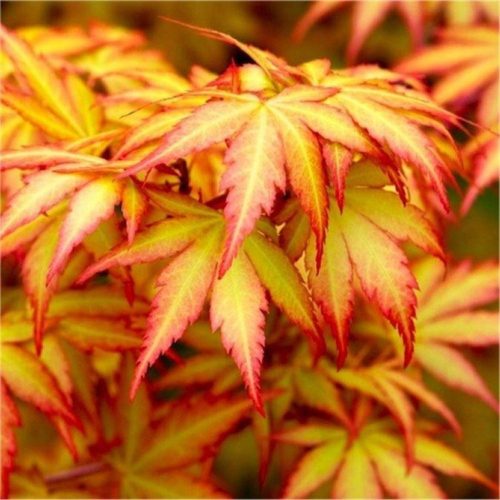

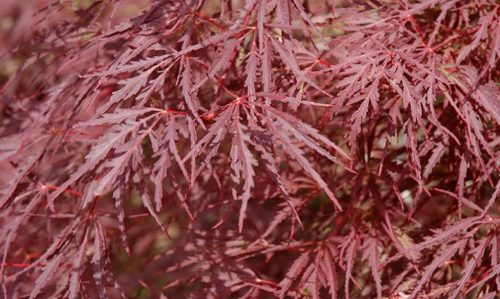

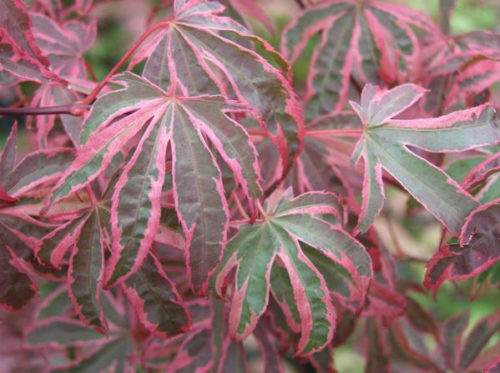

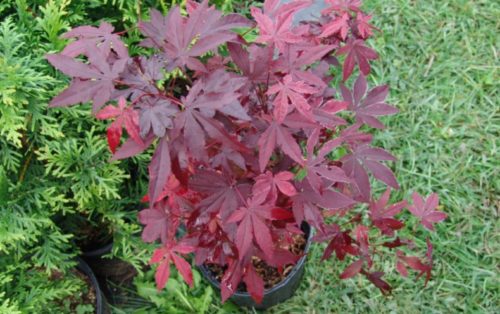
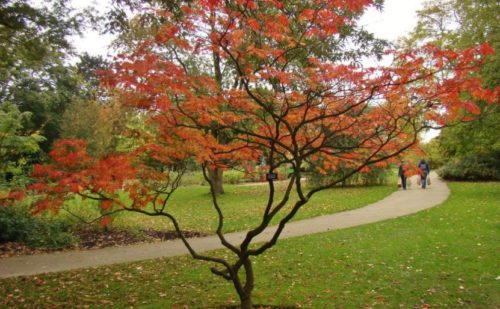
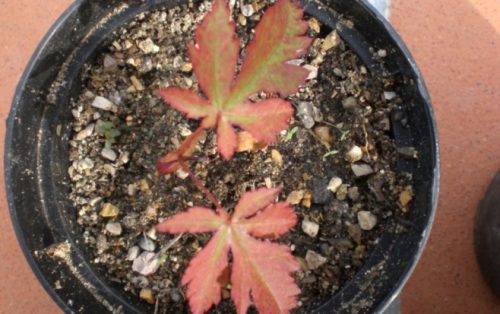
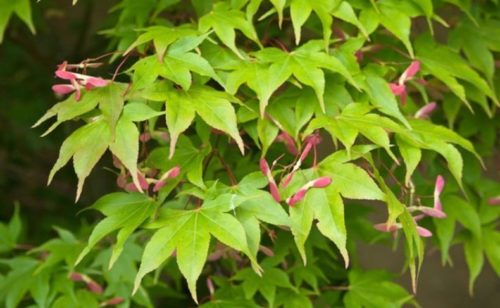
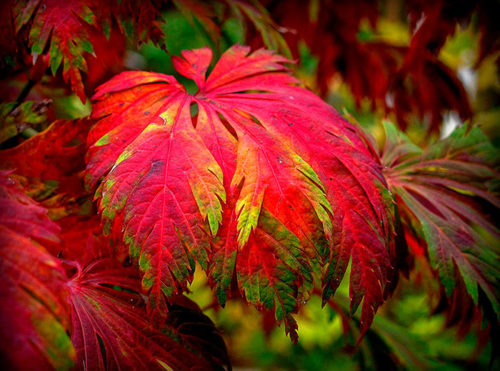
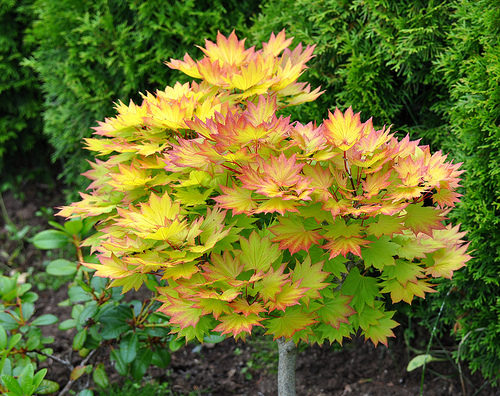
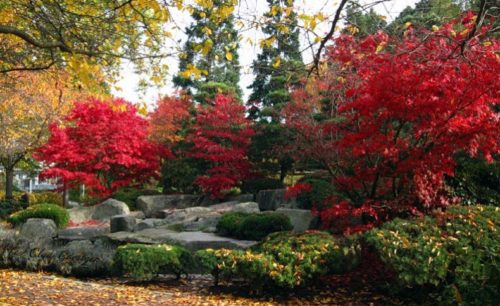
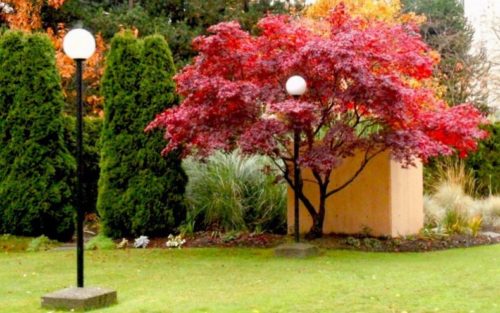
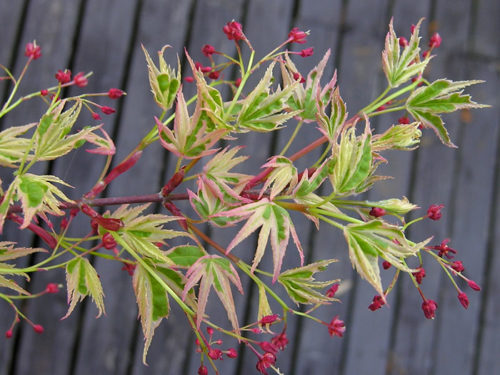
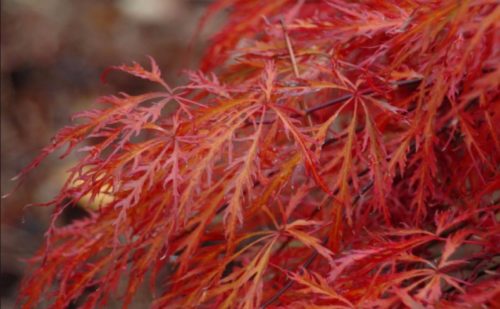












 Start a discussion ...
Start a discussion ...